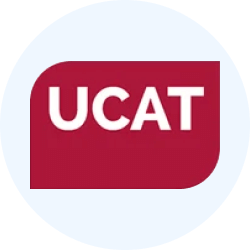UCAT Exam > UCAT Questions > In 2025, turbine blade efficiency has surged,...
Start Learning for Free
In 2025, turbine blade efficiency has surged, with 90-meter blades capturing 30% more energy than 2020 models. A 2024 study reported 60% of turbines use lightweight composites, reducing weight by 25% but increasing costs by 12%. Vestas, supplying 35% of global blades, leads innovation. High costs deter 20% of projects, though subsidies in 65% of countries cover 15% of expenses. Maintenance costs, at $50,000 annually per turbine, burden 25% of budgets. Public support, at 70% in wind-heavy regions, drives expansion. Regulations in 75% of countries enforce quality standards. Developing nations, with 40% of installations, face 45% higher maintenance costs due to skill shortages. Curved blades, adopted in 45% of new turbines, cut noise by 15%. These advancements are revolutionary for renewable energy, ensuring a sustainable future. Research, funded at $1.8 billion, explores recyclable composites.
What is the author’s purpose?
What is the author’s purpose?
- a)To inform
- b)To persuade
- c)To critique
- d)To describe
Correct answer is option 'B'. Can you explain this answer?
Most Upvoted Answer
In 2025, turbine blade efficiency has surged, with 90-meter blades cap...
The passage presents facts but emphasizes “revolutionary” advancements and a “sustainable future,” suggesting advocacy for turbine technology adoption, indicating a persuasive purpose.

|
Explore Courses for UCAT exam
|

|
Question Description
In 2025, turbine blade efficiency has surged, with 90-meter blades capturing 30% more energy than 2020 models. A 2024 study reported 60% of turbines use lightweight composites, reducing weight by 25% but increasing costs by 12%. Vestas, supplying 35% of global blades, leads innovation. High costs deter 20% of projects, though subsidies in 65% of countries cover 15% of expenses. Maintenance costs, at $50,000 annually per turbine, burden 25% of budgets. Public support, at 70% in wind-heavy regions, drives expansion. Regulations in 75% of countries enforce quality standards. Developing nations, with 40% of installations, face 45% higher maintenance costs due to skill shortages. Curved blades, adopted in 45% of new turbines, cut noise by 15%. These advancements are revolutionary for renewable energy, ensuring a sustainable future. Research, funded at $1.8 billion, explores recyclable composites. What is the author’s purpose?a)To informb)To persuadec)To critiqued)To describeCorrect answer is option 'B'. Can you explain this answer? for UCAT 2025 is part of UCAT preparation. The Question and answers have been prepared according to the UCAT exam syllabus. Information about In 2025, turbine blade efficiency has surged, with 90-meter blades capturing 30% more energy than 2020 models. A 2024 study reported 60% of turbines use lightweight composites, reducing weight by 25% but increasing costs by 12%. Vestas, supplying 35% of global blades, leads innovation. High costs deter 20% of projects, though subsidies in 65% of countries cover 15% of expenses. Maintenance costs, at $50,000 annually per turbine, burden 25% of budgets. Public support, at 70% in wind-heavy regions, drives expansion. Regulations in 75% of countries enforce quality standards. Developing nations, with 40% of installations, face 45% higher maintenance costs due to skill shortages. Curved blades, adopted in 45% of new turbines, cut noise by 15%. These advancements are revolutionary for renewable energy, ensuring a sustainable future. Research, funded at $1.8 billion, explores recyclable composites. What is the author’s purpose?a)To informb)To persuadec)To critiqued)To describeCorrect answer is option 'B'. Can you explain this answer? covers all topics & solutions for UCAT 2025 Exam. Find important definitions, questions, meanings, examples, exercises and tests below for In 2025, turbine blade efficiency has surged, with 90-meter blades capturing 30% more energy than 2020 models. A 2024 study reported 60% of turbines use lightweight composites, reducing weight by 25% but increasing costs by 12%. Vestas, supplying 35% of global blades, leads innovation. High costs deter 20% of projects, though subsidies in 65% of countries cover 15% of expenses. Maintenance costs, at $50,000 annually per turbine, burden 25% of budgets. Public support, at 70% in wind-heavy regions, drives expansion. Regulations in 75% of countries enforce quality standards. Developing nations, with 40% of installations, face 45% higher maintenance costs due to skill shortages. Curved blades, adopted in 45% of new turbines, cut noise by 15%. These advancements are revolutionary for renewable energy, ensuring a sustainable future. Research, funded at $1.8 billion, explores recyclable composites. What is the author’s purpose?a)To informb)To persuadec)To critiqued)To describeCorrect answer is option 'B'. Can you explain this answer?.
In 2025, turbine blade efficiency has surged, with 90-meter blades capturing 30% more energy than 2020 models. A 2024 study reported 60% of turbines use lightweight composites, reducing weight by 25% but increasing costs by 12%. Vestas, supplying 35% of global blades, leads innovation. High costs deter 20% of projects, though subsidies in 65% of countries cover 15% of expenses. Maintenance costs, at $50,000 annually per turbine, burden 25% of budgets. Public support, at 70% in wind-heavy regions, drives expansion. Regulations in 75% of countries enforce quality standards. Developing nations, with 40% of installations, face 45% higher maintenance costs due to skill shortages. Curved blades, adopted in 45% of new turbines, cut noise by 15%. These advancements are revolutionary for renewable energy, ensuring a sustainable future. Research, funded at $1.8 billion, explores recyclable composites. What is the author’s purpose?a)To informb)To persuadec)To critiqued)To describeCorrect answer is option 'B'. Can you explain this answer? for UCAT 2025 is part of UCAT preparation. The Question and answers have been prepared according to the UCAT exam syllabus. Information about In 2025, turbine blade efficiency has surged, with 90-meter blades capturing 30% more energy than 2020 models. A 2024 study reported 60% of turbines use lightweight composites, reducing weight by 25% but increasing costs by 12%. Vestas, supplying 35% of global blades, leads innovation. High costs deter 20% of projects, though subsidies in 65% of countries cover 15% of expenses. Maintenance costs, at $50,000 annually per turbine, burden 25% of budgets. Public support, at 70% in wind-heavy regions, drives expansion. Regulations in 75% of countries enforce quality standards. Developing nations, with 40% of installations, face 45% higher maintenance costs due to skill shortages. Curved blades, adopted in 45% of new turbines, cut noise by 15%. These advancements are revolutionary for renewable energy, ensuring a sustainable future. Research, funded at $1.8 billion, explores recyclable composites. What is the author’s purpose?a)To informb)To persuadec)To critiqued)To describeCorrect answer is option 'B'. Can you explain this answer? covers all topics & solutions for UCAT 2025 Exam. Find important definitions, questions, meanings, examples, exercises and tests below for In 2025, turbine blade efficiency has surged, with 90-meter blades capturing 30% more energy than 2020 models. A 2024 study reported 60% of turbines use lightweight composites, reducing weight by 25% but increasing costs by 12%. Vestas, supplying 35% of global blades, leads innovation. High costs deter 20% of projects, though subsidies in 65% of countries cover 15% of expenses. Maintenance costs, at $50,000 annually per turbine, burden 25% of budgets. Public support, at 70% in wind-heavy regions, drives expansion. Regulations in 75% of countries enforce quality standards. Developing nations, with 40% of installations, face 45% higher maintenance costs due to skill shortages. Curved blades, adopted in 45% of new turbines, cut noise by 15%. These advancements are revolutionary for renewable energy, ensuring a sustainable future. Research, funded at $1.8 billion, explores recyclable composites. What is the author’s purpose?a)To informb)To persuadec)To critiqued)To describeCorrect answer is option 'B'. Can you explain this answer?.
Solutions for In 2025, turbine blade efficiency has surged, with 90-meter blades capturing 30% more energy than 2020 models. A 2024 study reported 60% of turbines use lightweight composites, reducing weight by 25% but increasing costs by 12%. Vestas, supplying 35% of global blades, leads innovation. High costs deter 20% of projects, though subsidies in 65% of countries cover 15% of expenses. Maintenance costs, at $50,000 annually per turbine, burden 25% of budgets. Public support, at 70% in wind-heavy regions, drives expansion. Regulations in 75% of countries enforce quality standards. Developing nations, with 40% of installations, face 45% higher maintenance costs due to skill shortages. Curved blades, adopted in 45% of new turbines, cut noise by 15%. These advancements are revolutionary for renewable energy, ensuring a sustainable future. Research, funded at $1.8 billion, explores recyclable composites. What is the author’s purpose?a)To informb)To persuadec)To critiqued)To describeCorrect answer is option 'B'. Can you explain this answer? in English & in Hindi are available as part of our courses for UCAT.
Download more important topics, notes, lectures and mock test series for UCAT Exam by signing up for free.
Here you can find the meaning of In 2025, turbine blade efficiency has surged, with 90-meter blades capturing 30% more energy than 2020 models. A 2024 study reported 60% of turbines use lightweight composites, reducing weight by 25% but increasing costs by 12%. Vestas, supplying 35% of global blades, leads innovation. High costs deter 20% of projects, though subsidies in 65% of countries cover 15% of expenses. Maintenance costs, at $50,000 annually per turbine, burden 25% of budgets. Public support, at 70% in wind-heavy regions, drives expansion. Regulations in 75% of countries enforce quality standards. Developing nations, with 40% of installations, face 45% higher maintenance costs due to skill shortages. Curved blades, adopted in 45% of new turbines, cut noise by 15%. These advancements are revolutionary for renewable energy, ensuring a sustainable future. Research, funded at $1.8 billion, explores recyclable composites. What is the author’s purpose?a)To informb)To persuadec)To critiqued)To describeCorrect answer is option 'B'. Can you explain this answer? defined & explained in the simplest way possible. Besides giving the explanation of
In 2025, turbine blade efficiency has surged, with 90-meter blades capturing 30% more energy than 2020 models. A 2024 study reported 60% of turbines use lightweight composites, reducing weight by 25% but increasing costs by 12%. Vestas, supplying 35% of global blades, leads innovation. High costs deter 20% of projects, though subsidies in 65% of countries cover 15% of expenses. Maintenance costs, at $50,000 annually per turbine, burden 25% of budgets. Public support, at 70% in wind-heavy regions, drives expansion. Regulations in 75% of countries enforce quality standards. Developing nations, with 40% of installations, face 45% higher maintenance costs due to skill shortages. Curved blades, adopted in 45% of new turbines, cut noise by 15%. These advancements are revolutionary for renewable energy, ensuring a sustainable future. Research, funded at $1.8 billion, explores recyclable composites. What is the author’s purpose?a)To informb)To persuadec)To critiqued)To describeCorrect answer is option 'B'. Can you explain this answer?, a detailed solution for In 2025, turbine blade efficiency has surged, with 90-meter blades capturing 30% more energy than 2020 models. A 2024 study reported 60% of turbines use lightweight composites, reducing weight by 25% but increasing costs by 12%. Vestas, supplying 35% of global blades, leads innovation. High costs deter 20% of projects, though subsidies in 65% of countries cover 15% of expenses. Maintenance costs, at $50,000 annually per turbine, burden 25% of budgets. Public support, at 70% in wind-heavy regions, drives expansion. Regulations in 75% of countries enforce quality standards. Developing nations, with 40% of installations, face 45% higher maintenance costs due to skill shortages. Curved blades, adopted in 45% of new turbines, cut noise by 15%. These advancements are revolutionary for renewable energy, ensuring a sustainable future. Research, funded at $1.8 billion, explores recyclable composites. What is the author’s purpose?a)To informb)To persuadec)To critiqued)To describeCorrect answer is option 'B'. Can you explain this answer? has been provided alongside types of In 2025, turbine blade efficiency has surged, with 90-meter blades capturing 30% more energy than 2020 models. A 2024 study reported 60% of turbines use lightweight composites, reducing weight by 25% but increasing costs by 12%. Vestas, supplying 35% of global blades, leads innovation. High costs deter 20% of projects, though subsidies in 65% of countries cover 15% of expenses. Maintenance costs, at $50,000 annually per turbine, burden 25% of budgets. Public support, at 70% in wind-heavy regions, drives expansion. Regulations in 75% of countries enforce quality standards. Developing nations, with 40% of installations, face 45% higher maintenance costs due to skill shortages. Curved blades, adopted in 45% of new turbines, cut noise by 15%. These advancements are revolutionary for renewable energy, ensuring a sustainable future. Research, funded at $1.8 billion, explores recyclable composites. What is the author’s purpose?a)To informb)To persuadec)To critiqued)To describeCorrect answer is option 'B'. Can you explain this answer? theory, EduRev gives you an
ample number of questions to practice In 2025, turbine blade efficiency has surged, with 90-meter blades capturing 30% more energy than 2020 models. A 2024 study reported 60% of turbines use lightweight composites, reducing weight by 25% but increasing costs by 12%. Vestas, supplying 35% of global blades, leads innovation. High costs deter 20% of projects, though subsidies in 65% of countries cover 15% of expenses. Maintenance costs, at $50,000 annually per turbine, burden 25% of budgets. Public support, at 70% in wind-heavy regions, drives expansion. Regulations in 75% of countries enforce quality standards. Developing nations, with 40% of installations, face 45% higher maintenance costs due to skill shortages. Curved blades, adopted in 45% of new turbines, cut noise by 15%. These advancements are revolutionary for renewable energy, ensuring a sustainable future. Research, funded at $1.8 billion, explores recyclable composites. What is the author’s purpose?a)To informb)To persuadec)To critiqued)To describeCorrect answer is option 'B'. Can you explain this answer? tests, examples and also practice UCAT tests.

|
Explore Courses for UCAT exam
|

|
Signup for Free!
Signup to see your scores go up within 7 days! Learn & Practice with 1000+ FREE Notes, Videos & Tests.


















